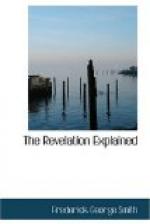The next object in the vision is the locusts that came out of the smoke, to which was given power like scorpions, or power to inflict a deadly sting like scorpions. To what living agents, then, did the delusion of Mohammedanism give birth—agents of a destructive nature like scorpion locust? Evidently, the Saracens,[6] those warrior followers of Mohammed who flocked to his standard. These locusts received the express command that “they should not hurt the grass of the earth, neither any green thing, neither any tree; but only those men which have not the seal of God in their foreheads.” The successor of Mohammed, Abubeker, gave the Saracens a command that they should “destroy no palm-trees, nor burn any fields of grain; cut down no fruit-trees, nor do any mischief to cattle, only such as you kill to eat.” This command was singular, yet it doubtless is not the fulfilment of the command to the locusts; for that would be adopting a literal meaning instead of a symbolic one, and to complete the picture we should have had literal Saracens instead of locusts. We can not consistently make a part literal and the remainder symbolical. In the explanation of the first trumpet (chap. 8:6, 7), we showed that grass and trees symbolized the inhabitants of a kingdom, grass representing the feebler and trees the stronger portions of society. The fact, then, that these locusts were not to destroy the green grass and trees show that they were not sent as a scourge upon the political empire only, as was the storm of hail and fire under the first trumpet. Had their mission been like that of natural locusts, to destroy every green thing, we should then conclude that they were sent as a scourge upon the empire alone, having nothing whatever to do with a system of religion. These locusts, however, were commanded not to do what natural locusts always do—eat green grass and trees—and were commissioned to do what locusts never do—“hurt men,” but only those who have not the seal of God in their foreheads; that is, the worshipers of a false, idolatrous church, who are not known unto God as his true people. This is positive proof that the design of this vision is to set forth some awful religious imposture; for the “men” that they were to hurt are found in the department which by analogy represents religious events.
[Footnote 6: “In earlier times the name of Saraceni was applied by Greeks and Romans to the troublesome Nomad Arabs of the Syro-Arabian desert.”—Encyclopaedia Britannica. In the Middle Ages, however, Europeans began to call all their Moslem enemies Saracens. It is in the limited sense that it is here applied, designating the first followers of Mohammed before the rise of the Ottoman empire.]




